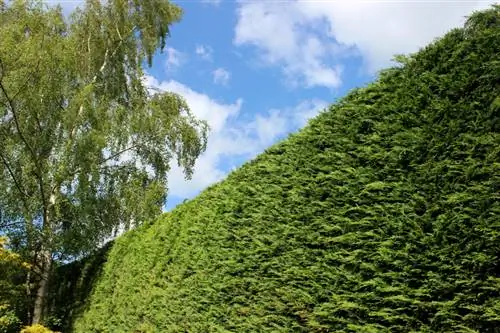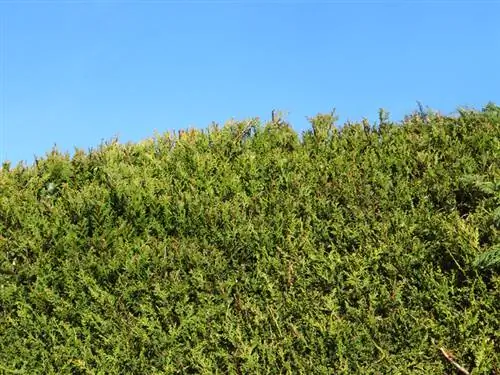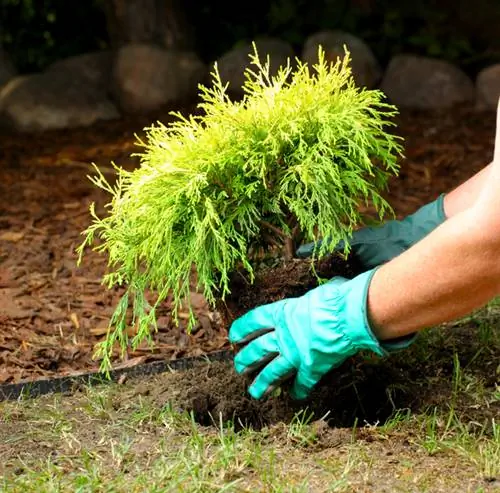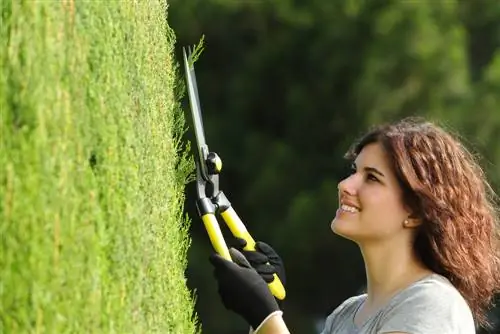- Author admin [email protected].
- Public 2023-12-16 16:46.
- Last modified 2025-06-01 06:02.
Read a commented hybrid cypress profile here with explanations of growth, leaves and flowers. Planting and care tips worth knowing for Cupressocyparis leylandii as a hedge plant.
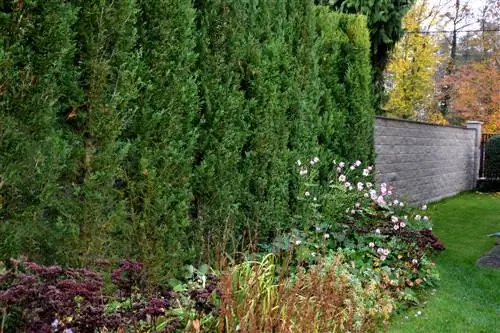
What is special about a bastard cypress?
The bastard cypress is an evergreen conifer that is popular as a hedge plant. Its height is 8 to 30 meters and it is characterized by its fast growth, easy-care properties and winter-hardy nature. The leaves are needle-shaped and scale-shaped, while the flowers form cones.
Profile
- Scientific name: Cupressocyparis leylandii
- Family: Cypress family (Cupressaceae)
- Synonyms: Leyland cypress, bastard cypress
- Occurrence: Europe
- Growth type: Conifer
- Growth habit: conical
- Growth height: 8 m to 30 m
- Leaf: needle-shaped, scale-shaped
- Flower: cones
- Fruit: Cones
- Winter hardiness: hardy
- Use: hedge plant
Growth
The bastard cypress is a large, evergreen conifer that can grow very quickly and very densely. Cupressocyparis leylandii is the successful result of a cross between Monterey cypress (Cupressus macrocarpa) and Nootka cypress (Xanthocyparis nootkatensis). The shapely cypress is also known to hobby gardeners under the names Leyland cypress, Cuprocyparis leylandii and Leylandii cypress. The bastard cypress is mainly planted as a hedge. These key growth data illustrate why this is the case:
- Growth habit: upright, bushy cypress with a conical silhouette; opaque branching; flattened, slightly overhanging branches with evergreen, scale-shaped needles.
- Growth height: 8 m to 25 m, rarely up to 30 m.
- Growth width: 1, 50 m to 5 m.
- Roots: Shallow roots
- Growth speed: 40 cm to 100 cm, under ideal conditions up to 150 cm growth per year.
- Gardenically interesting properties: easy to care for, hardy, tolerates pruning, evergreen, opaque all year round, stable to snow pressure, slightly toxic, fastest growing cypress.
Video: Garden professional Herbert Geringer introduces the bastard cypress as a hedge plant
Leaf
The leaf organs of a bastard cypress are characterized by these properties:
- leaf shape: needle-shaped
- Arrangement: scale-shaped
- Leaf color: evergreen, dark green (varieties also yellow-green, gray-green or blue-green).
- Texture: soft, scaly-rough, flexible.
- Special feature: unprotected skin contact can trigger allergic reactions.
Bloom
The bastard cypress grows monoeciously with separate sexes. Male and female flowers sit harmoniously on a conifer. A male flower is elongated. The female counterpart is spherical. However, flower cones can rarely be admired because a Leyland cypress is regularly cut as a hedge plant.
Excursus
Leylandii 2001 - denser, more compact, simply better
Compared to Leylandii 2001, the original Cupressocyparis species is left behind. The 'Type 2001' variety impresses with denser branching and more compact growth. This means that the optimized bastard cypress has all the important properties for a premium quality Leyland cypress hedge.
Planting bastard cypress
As a container product, the bastard cypress can be planted all year round. The only requirement is a frost-free ground. The best planting time is from September to early November and again in March/April. In autumn and spring you can buy ready-to-plant Leyland cypresses in various qualities. Even beginners can easily master the choice of location and planting technique. You can read how to properly plant a Leyland cypress hedge here:
Buy Cupressocyparis leylandii
It costs (roughly estimated) between 900 euros and 3 euros to plant a 10 meter long Leyland cypress hedge from 100 centimeter tall young plants. Calculate 900 euros. With the maximum volume discount, the price drops to around 260 euros. The following table illustrates the benefits of a price comparison:
| Buy Leyland Cypress | Type of origin | Type 2001 | from 100 pieces |
|---|---|---|---|
| 60-80 cm | 13, 99 euros | 22, 99 euros | 7, 40 euros |
| 100-125 cm | 29, 99 euros | 129, 99 euros | 8, 65 euros |
| 125-150 cm | 87, 99 euros | 159, 99 euros | 15, 95 euros |
| 150-200 cm | 159, 99 euros | 219, 99 euros | 21, 95 euros |
| 200-225 cm | 274, 99 euros | 302, 49 euros | 24, 80 euros |
| 300-350 cm | 1,451, 99 euros | 1,500 euros | NN |
Location
Basically, a bastard cypress grows where you plant the conifer. A location with these basic conditions is advantageous for rapid growth into an opaque wind and privacy hedge:
- Sun to partial shade.
- Normal garden soil, preferably nutrient-rich, fresh, moist and loose and permeable.
Extra tip for builders: If the Leyland cypress hedge is planted on a new building plot, a 30 cm to 50 cm thick layer of topsoil is optimal.
Planting Tips
Good preparation is just as important as competent planting techniques and initial care. These tips get to the heart of how to properly plant Cupressocyparis leylandii as a hedge:
- The correct hedge course is measured and marked with stretched cords.
- Ideally, the conifer hedge is planted in a trench and not in individual planting holes.
- Heavy clay soil is optimized with sand, light sandy soil is optimized with compost.
- The planting distance is 30 cm to 100 cm, depending on the height of growth and the desired duration until the privacy function.
- On planting day or next spring, the bastard cypress receives its first pruning by a third.
- Pervasive watering and mulching with bark mulch are the first care measures.
Balcony gardeners plant the bastard cypress in a large pot with a height and diameter of at least 40 centimeters as wind and privacy protection. A 10 centimeter thick layer of expanded clay on the bottom of the bucket prevents waterlogging. High-quality potted plant soil without peat, enriched with lava granules or expanded clay, is suitable as a substrate.
Care for the bastard cypress
The bastard cypress is easy to care for. The mainstays of the simple care program are a continuous water supply, seasonal nutrient supply and pruning twice a year. Read the best care tips for Cupressocyparis leylandii as a hedge plant here:
Pouring
- In dry conditions, water the bastard cypress promptly as soon as the soil feels dry.
- Use primarily rainwater or stale tap water for watering.
- Evergreen conifers should be watered when there is frost, even in winter on mild days.
Fertilize
- In March and June, fertilize with 3 liters of compost and 100 grams of horn shavings (€52.00 on Amazon) per square meter.
- Alternatively, administer an organic-mineral conifer fertilizer according to the manufacturer's instructions.
Cutting
As a fast-growing hedge plant, the bastard cypress is pruned two to three times a year. You can read detailed cutting instructions here. You can read a compact summary in these tips & tricks:
- Cutting dates: February/beginning of March (main date), end of June (care cutting), mid/end of August (optional).
- Rule of thumb cutting: Only prune in the green needled area.
- Cut shape: Cut the Leyland cypress hedge in a conical trapezoid shape (wide base, narrower crown).
After pruning, the bastard cypress is grateful for a portion of compost with horn shavings. After a final pruning in August, the conifer benefits as a hedge plant or solitary from organic fertilization with comfrey manure.
Propagate
The bastard cypress is easy to propagate through cuttings. The following quick guide explains how to do it correctly:
- The best time is in early summer.
- Tear off half-woody, two-year-old twigs as cracks from the branch along with a tongue of bark.
- Leave the bottom of the cuttings and cut them to 10 cm to 15 cm.
- Dip the interface including the bark tongue in root activator.
- Let the cuttings root in a bowl of moist coconut soil in a bright, warm location.
Diseases and pests
The bastard cypress is spared from diseases and pests. Brown needle discoloration is a reaction to drought stress. Regular watering in dry conditions is therefore a must in gardening.
Popular varieties
These beautiful bastard cypress varieties bring more color into play, inspire as a cypress column or decorate the small garden:
- Gold Rider: Yellow bastard cypress as a solitary and hedge plant with golden yellow foliage and particularly fast growth, height 7 m to 12 m, growth width 3 m to 4 m.
- Castlewellan Gold: Large-growing yellow bastard cypress with a height of up to 25 m and robust winter hardiness down to -35° Celsius.
- Ice Column à Italia: Direct import from Italy with a slim, columnar silhouette, growth height 8 m to 30 m, growth width 1.50 m to 4.50 m.
- Blue Jeans: Leyland cypress for the small garden with blue-green, scale-shaped needles, height 3.50 m to 4.50 m.
FAQ
Is the bastard cypress poisonous?
Botanists and nurserymen classify the bastard cypress as slightly poisonous. Unprotected skin contact can cause itchy, allergic reactions in sensitive people. In contrast to other evergreen hedge plants, such as yew (Taxus) or arborvitae (Thuja), the conifer can definitely be planted in the family garden.
How often should you prune a Leyland cypress hedge?
For opaque, rapid growth, a Leyland cypress hedge should be trimmed at least twice a year. The best time for extensive shape and maintenance pruning is in February. In June/July, cut back this year's growth to the desired extent. Please always limit pruning to the green needled shoot area. A bastard cypress no longer sprouts from old wood.
Is it possible to transplant a bastard cypress planted the previous year?
You can easily transplant a bastard cypress within the first five years of growth. The best time is in early spring, as soon as the ground is frost-free. It is important to ensure a good supply of water and nutrients so that the Leylandii cypress can grow well in the new location.
How old can a Leyland cypress grow as a hedge?
The Leyland cypress, also known as the bastard cypress, is a cross between the true Monterey cypress (Cupressus macrocarpa) and the Nootka cypress (Xanthocyparis nootkatensis). Both parents are among the particularly long-lived cypress plants. This means that a Leyland cypress hedge can live up to 200 years if well cared for.
Does the bastard cypress as a hedge plant need winter protection in the planting year?
In harsh winter locations, winter protection makes sense in the planting year. In severe frost, the tips of the branches can freeze. Winter weather with sunshine and temperatures below freezing is particularly dangerous. Needles warmed by sunshine evaporate water that the roots in frozen ground cannot supply. In technical terms, this phenomenon is known as cold frost or frost drying. The best winter protection is a temporary cover with plant fleece.


